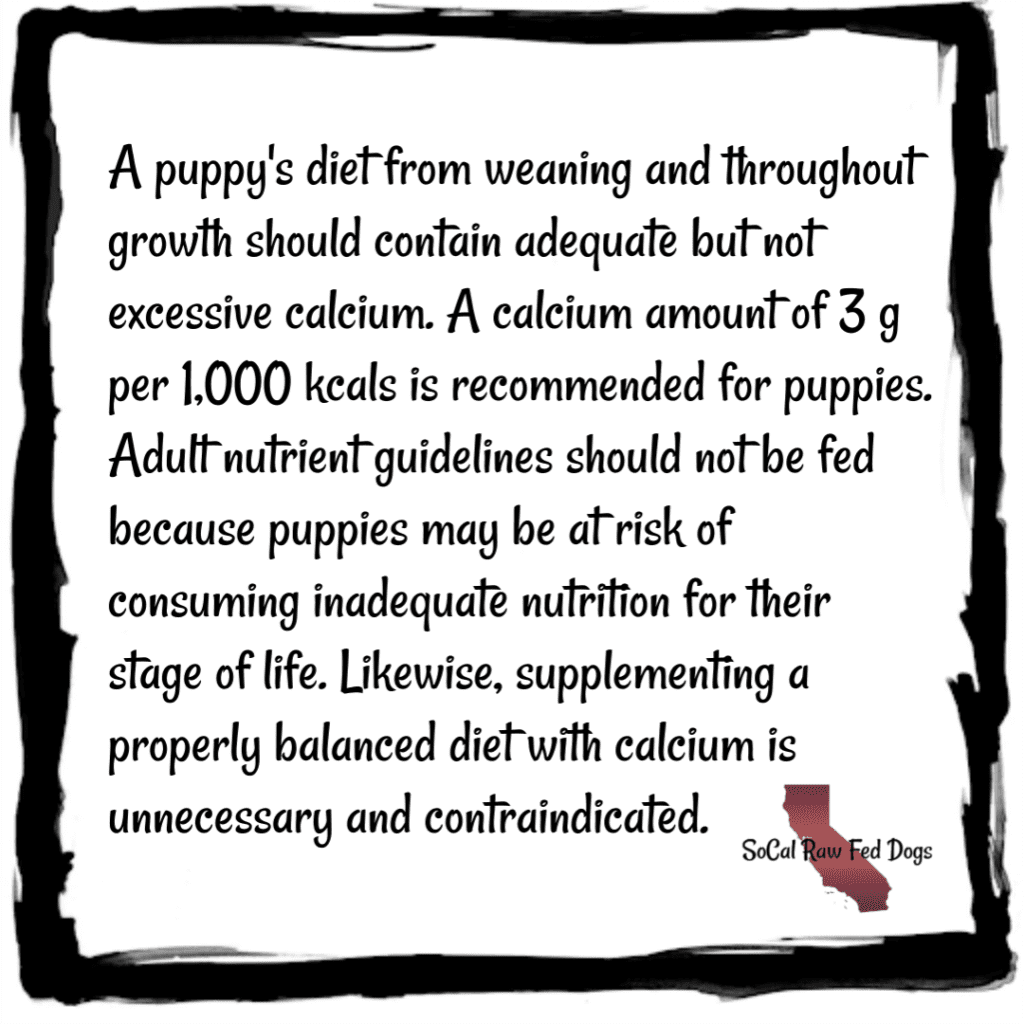Click the Arrow to Access the Table of Contents Links
Feeding Large & Extra Large Breed Puppies
Energy, Fat & Protein
Calcium Metabolism
 Puppies younger than six months old cannot fully regulate calcium absorption yet. Too little calcium can affect a puppy’s growth rate + their bone mineral content & strength; while too much can increase the risk of Hypertrophic Osteodystrophy (HOD). The requirements for calcium depend on breed and age.
Puppies younger than six months old cannot fully regulate calcium absorption yet. Too little calcium can affect a puppy’s growth rate + their bone mineral content & strength; while too much can increase the risk of Hypertrophic Osteodystrophy (HOD). The requirements for calcium depend on breed and age. Calcium Requirements
Vitamin D
Vitamin D is composed of a group of sterol compounds that regulate calcium and phosphorus metabolism in the body. There are two pro-vitamin forms of this vitamin.
- Vitamin D2 (ergocalciferol)
- D2 is formed when the compound ergosterol is exposed to ultraviolet radiation (UV Rays). D2 is found in many plants and the conversion is only possible in harvested or “injured” plants, not living plant tissue.
- D2 is only of significance to ruminant & non ruminant herbivores eating sun-dried or irradiated plant materials. D2 is used less efficiently than D3 by dogs.
- Vitamin D3 (cholecalciferol)
- D3 is of great nutritional importance to dogs, and they are dependent on getting it via dietary sourcing because they have limited ability to convert 7-dehydrocholesterol in the skin to cholecalciferol.
Vitamin D’s functions are intricately involved with normal calcium and phosphorus homeostasis in the body. At the site of the intestine, vitamin D stimulates the synthesis of calcium-binding protein, which is needed for efficient absorption of dietary calcium & phosphorus. Vitamin D affects normal bone growth & calcification by acting with Parathyroid Hormone (PHT) to mobilize calcium from bone and by causing an increase in phosphate reabsorption in the kidneys. <—- What does all that mean?! It means vitamin D’s actions in the intestines, bones, and kidneys creates an increase in plasma calcium and phosphorus, to the level needed for normal mineralization of bone.
Dietary sources of vitamin D3 for dogs are relatively low. Moderate amounts can be found in foods such as mackerel, salmon, whole egg, turkey liver, beef liver, beef kidney, domesticated duck meat, and turkey heart. Fish liver oils and cod liver oil are two concentrated food sources of vitamin D. Cod liver oil should be used with caution and careful attention paid to the amount given.
Critical Recap: Vitamin D3 plays an important role in regulating calcium and phosphorus metabolism. A deficiency in vitamin D3 can impact bone mineralization and cause skeletal issues.
Read more about Vitamin D and the Foods that Offer High Amounts of it Here
Effects of Complex Carbohydrates on Growth
Starch is not needed to balance a puppy’s diet nor is it recommended as a main component of a puppy’s diet. Complex carbohydrates are starches or fibers, which are digested more slowly than simple carbohydrates. Starch requires additional breakdown by enzymes that are produced by the pancreas and intestinal wall. When starch isn’t prepared properly or it is fed in excess, it can rob the puppy of essential nutrients and starch can also create systemic yeast infections. Sometimes people reach for starch to fill calories with but we do not want to do that in growth and so leaving starch out of a growing puppy’s diet is best.
Fiber and Growth
It is important to provide fiber in moderation but fiber sources shouldn’t be looked to for balancing a diet. Dietary fiber reduces energy intake by way of dilution. Feed fiber that is in the form of low glycemic vegetables or high fiber, lower sugar fruits. Fiber is best fed to growing puppies after a meal, not before. Fiber is discussed more in depth in other puppy guides here on the website.

Hello, thank you for this blog…I am feeding my puppy home cooked meals because she got sick with industrial meals. My vet is no help, he just wants to switch food and I want to make her a balanced meal.
If I calculate how much calcium my Great Pyrenees should need I get as follow:
31kg, 7 months intact, as per your calculator is 2732.65 Kcal/per day (she is quite active puppy)
That means I need approximately 8g of calcium per day (if I need 3g/1000 kcal)
UPCO bone meal lists on their website that a teaspoon of their bone meal has 720mg (or 0.72g). That means that I have to give her 11 teaspoons of bone meal per day when the packages suggests 1! Is that correct? It seems way off!
Hello Gabriella! I am sorry, I am just seeing your comment today.
The bone meal isn’t only calcium so you would need to specifically formulate the recipe using its information.
Like!! I blog quite often and I genuinely thank you for your information. The article has truly peaked my interest.
I want to learn how to make my own raw food for my dogs but it seems extremely complicated. I have read several articles but calcium percentages etc, make absolutely no sense to me. I currently rotate Primal frozen raw.
I seen this posted in the raw feeding community on Facebook and have a mastiff puppy we feed raw to. Should I use the bone calculator to lower the % ? We don’t feed by calories so I was thinking if I used the calculator it would lower the calcium right? Thank you for any help.
I wondered about the calcium to phosphorus for bigger dogs being skewed by the supplement tabs my breeder has us giving. Thank you for this article it is helpful.
This is so true. Lower calcium for big puppies helps keep their bones healthy. People don’t think they need to watch the vitamin D either.
Thank you for the vitamin d examples, it helps me.
Thank you for this Amy! One of the companies we have here in SoCal pushes adding Nuvet to her products but her food is AAFCO complete and balanced and she owns giant dogs too. This was a great read for me this morning.
How do I go about finding the right raw food for my Dane?